engine VOLVO V70 1999 User Guide
[x] Cancel search | Manufacturer: VOLVO, Model Year: 1999, Model line: V70, Model: VOLVO V70 1999Pages: 61, PDF Size: 0.88 MB
Page 38 of 61
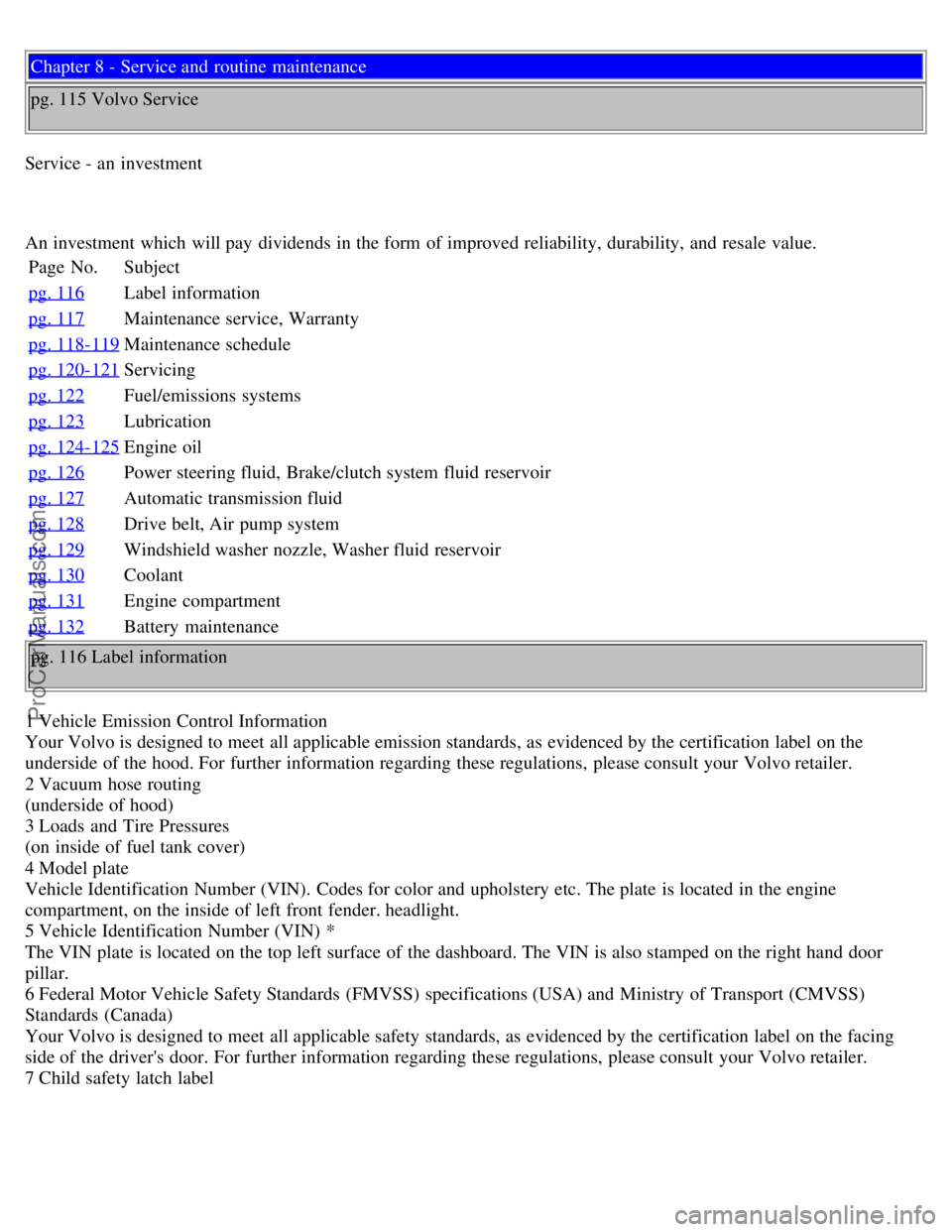
Chapter 8 - Service and routine maintenance
pg. 115 Volvo Service
Service - an investment
An investment which will pay dividends in the form of improved reliability, durability, and resale value. Page No. Subject
pg. 116
Label information
pg. 117
Maintenance service, Warranty
pg. 118-119
Maintenance schedule
pg. 120-121
Servicing
pg. 122
Fuel/emissions systems
pg. 123
Lubrication
pg. 124-125
Engine oil
pg. 126
Power steering fluid, Brake/clutch system fluid reservoir
pg. 127
Automatic transmission fluid
pg. 128
Drive belt, Air pump system
pg. 129
Windshield washer nozzle, Washer fluid reservoir
pg. 130
Coolant
pg. 131
Engine compartment
pg. 132
Battery maintenance
pg. 116 Label information
1 Vehicle Emission Control Information
Your Volvo is designed to meet all applicable emission standards, as evidenced by the certification label on the
underside of the hood. For further information regarding these regulations, please consult your Volvo retailer.
2 Vacuum hose routing
(underside of hood)
3 Loads and Tire Pressures
(on inside of fuel tank cover)
4 Model plate
Vehicle Identification Number (VIN). Codes for color and upholstery etc. The plate is located in the engine
compartment, on the inside of left front fender. headlight.
5 Vehicle Identification Number (VIN) *
The VIN plate is located on the top left surface of the dashboard. The VIN is also stamped on the right hand door
pillar.
6 Federal Motor Vehicle Safety Standards (FMVSS) specifications (USA) and Ministry of Transport (CMVSS)
Standards (Canada)
Your Volvo is designed to meet all applicable safety standards, as evidenced by the certification label on the facing
side of the driver's door. For further information regarding these regulations, please consult your Volvo retailer.
7 Child safety latch label
ProCarManuals.com
Page 40 of 61
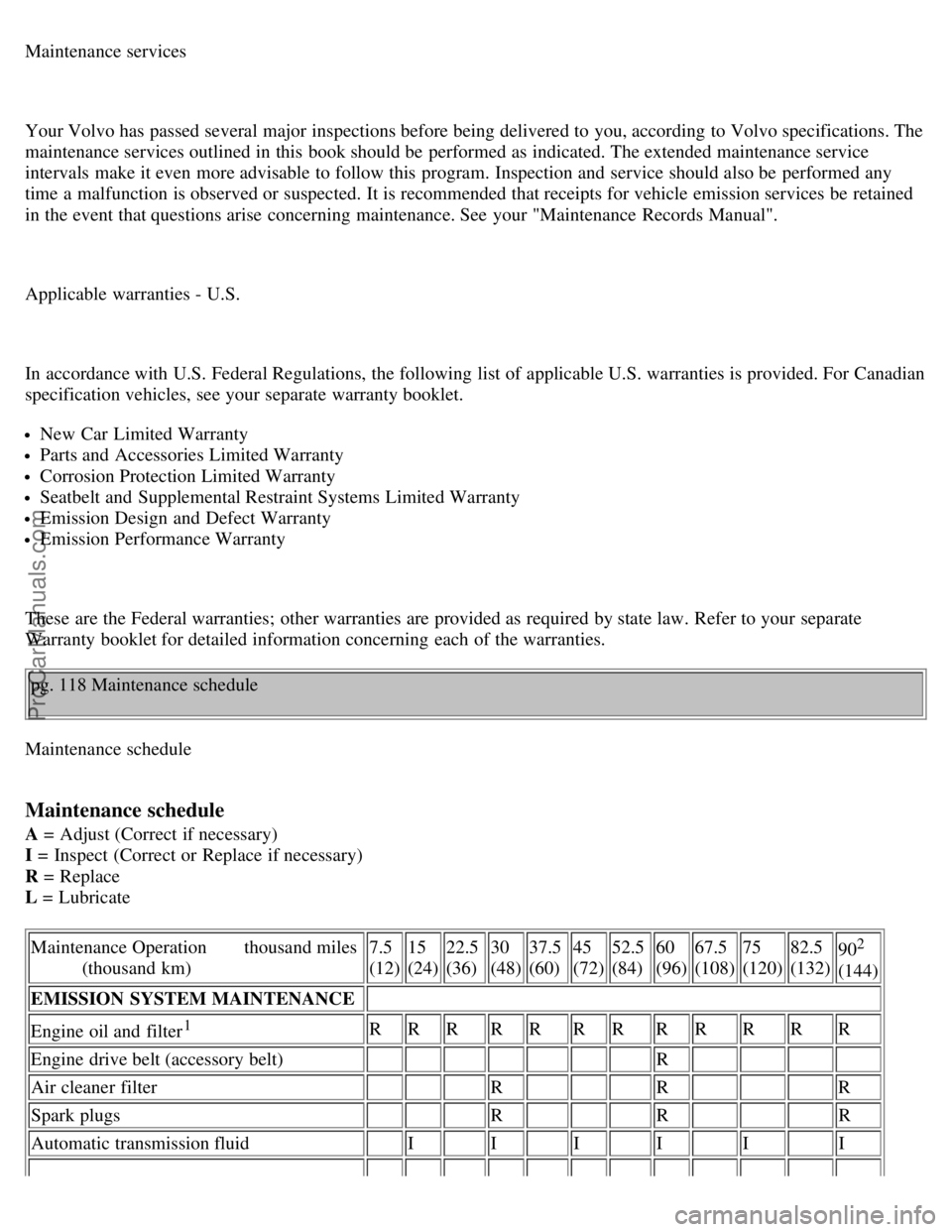
Maintenance services
Your Volvo has passed several major inspections before being delivered to you, according to Volvo specifications. The
maintenance services outlined in this book should be performed as indicated. The extended maintenance service
intervals make it even more advisable to follow this program. Inspection and service should also be performed any
time a malfunction is observed or suspected. It is recommended that receipts for vehicle emission services be retained
in the event that questions arise concerning maintenance. See your "Maintenance Records Manual".
Applicable warranties - U.S.
In accordance with U.S. Federal Regulations, the following list of applicable U.S. warranties is provided. For Canadian
specification vehicles, see your separate warranty booklet.
New Car Limited Warranty
Parts and Accessories Limited Warranty
Corrosion Protection Limited Warranty
Seatbelt and Supplemental Restraint Systems Limited Warranty
Emission Design and Defect Warranty
Emission Performance Warranty
These are the Federal warranties; other warranties are provided as required by state law. Refer to your separate
Warranty booklet for detailed information concerning each of the warranties. pg. 118 Maintenance schedule
Maintenance schedule
Maintenance schedule
A = Adjust (Correct if necessary)
I = Inspect (Correct or Replace if necessary)
R = Replace
L = Lubricate
Maintenance Operation thousand miles
(thousand km) 7.5
(12)15
(24)22.5
(36) 30
(48)37.5
(60) 45
(72)52.5
(84) 60
(96)67.5
(108) 75
(120)82.5
(132)
90
2
(144)
EMISSION SYSTEM MAINTENANCE
Engine oil and filter
1R RR RR RR RR RRR
Engine drive belt (accessory belt) R
Air cleaner filter R R R
Spark plugs R R R
Automatic transmission fluid I I I I I I
ProCarManuals.com
Page 41 of 61
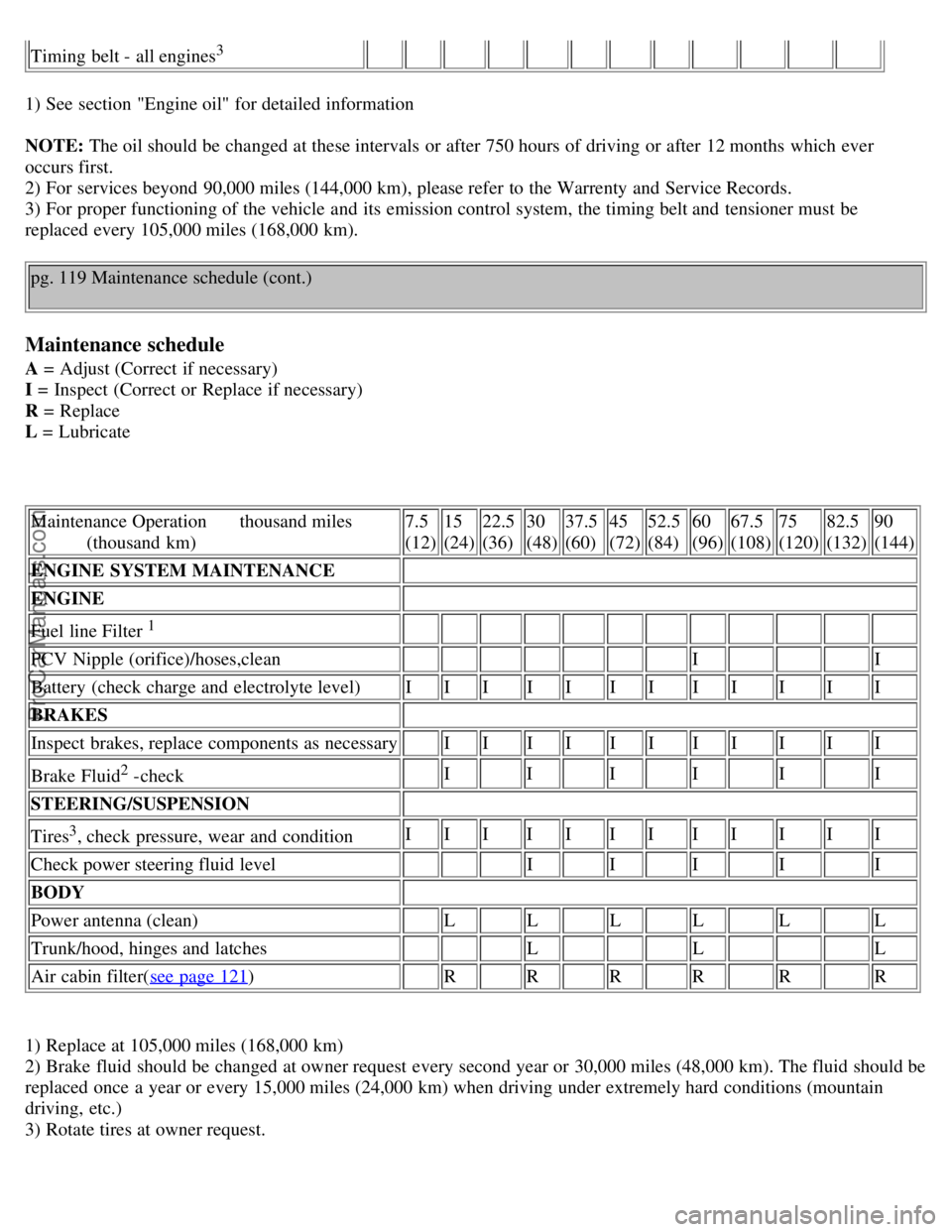
Timing belt - all engines3
1) See section "Engine oil" for detailed information
NOTE: The oil should be changed at these intervals or after 750 hours of driving or after 12 months which ever
occurs first.
2) For services beyond 90,000 miles (144,000 km), please refer to the Warrenty and Service Records.
3) For proper functioning of the vehicle and its emission control system, the timing belt and tensioner must be
replaced every 105,000 miles (168,000 km).
pg. 119 Maintenance schedule (cont.)
Maintenance schedule
A = Adjust (Correct if necessary)
I = Inspect (Correct or Replace if necessary)
R = Replace
L = Lubricate
Maintenance Operation thousand miles
(thousand km) 7.5
(12)15
(24)22.5
(36) 30
(48)37.5
(60) 45
(72)52.5
(84) 60
(96)67.5
(108) 75
(120)82.5
(132)90
(144)
ENGINE SYSTEM MAINTENANCE
ENGINE
Fuel line Filter
1
PCV Nipple (orifice)/hoses,clean I I
Battery (check charge and electrolyte level) III II II II III
BRAKES
Inspect brakes, replace components as necessary II II II II III
Brake Fluid
2 -check
I I I I I I
STEERING/SUSPENSION
Tires
3, check pressure, wear and condition I
II II II II III
Check power steering fluid level I I I I I
BODY
Power antenna (clean) L L L L L L
Trunk/hood, hinges and latches L L L
Air cabin filter( see page 121
) R R R R R R
1) Replace at 105,000 miles (168,000 km)
2) Brake fluid should be changed at owner request every second year or 30,000 miles (48,000 km). The fluid should be
replaced once a year or every 15,000 miles (24,000 km) when driving under extremely hard conditions (mountain
driving, etc.)
3) Rotate tires at owner request.
ProCarManuals.com
Page 42 of 61
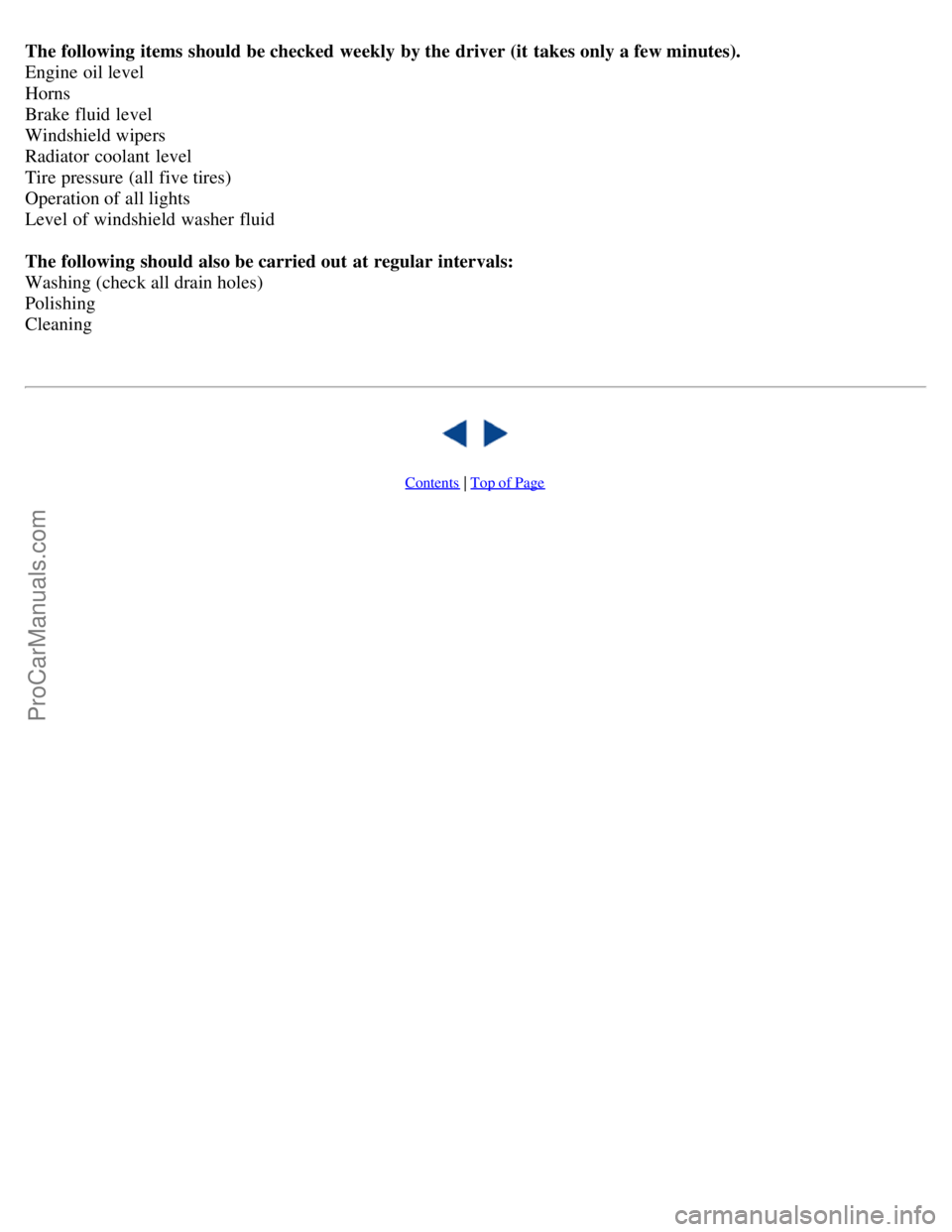
The following items should be checked weekly by the driver (it takes only a few minutes).
Engine oil level
Horns
Brake fluid level
Windshield wipers
Radiator coolant level
Tire pressure (all five tires)
Operation of all lights
Level of windshield washer fluid
The following should also be carried out at regular intervals:
Washing (check all drain holes)
Polishing
Cleaning
Contents | Top of Page
ProCarManuals.com
Page 43 of 61
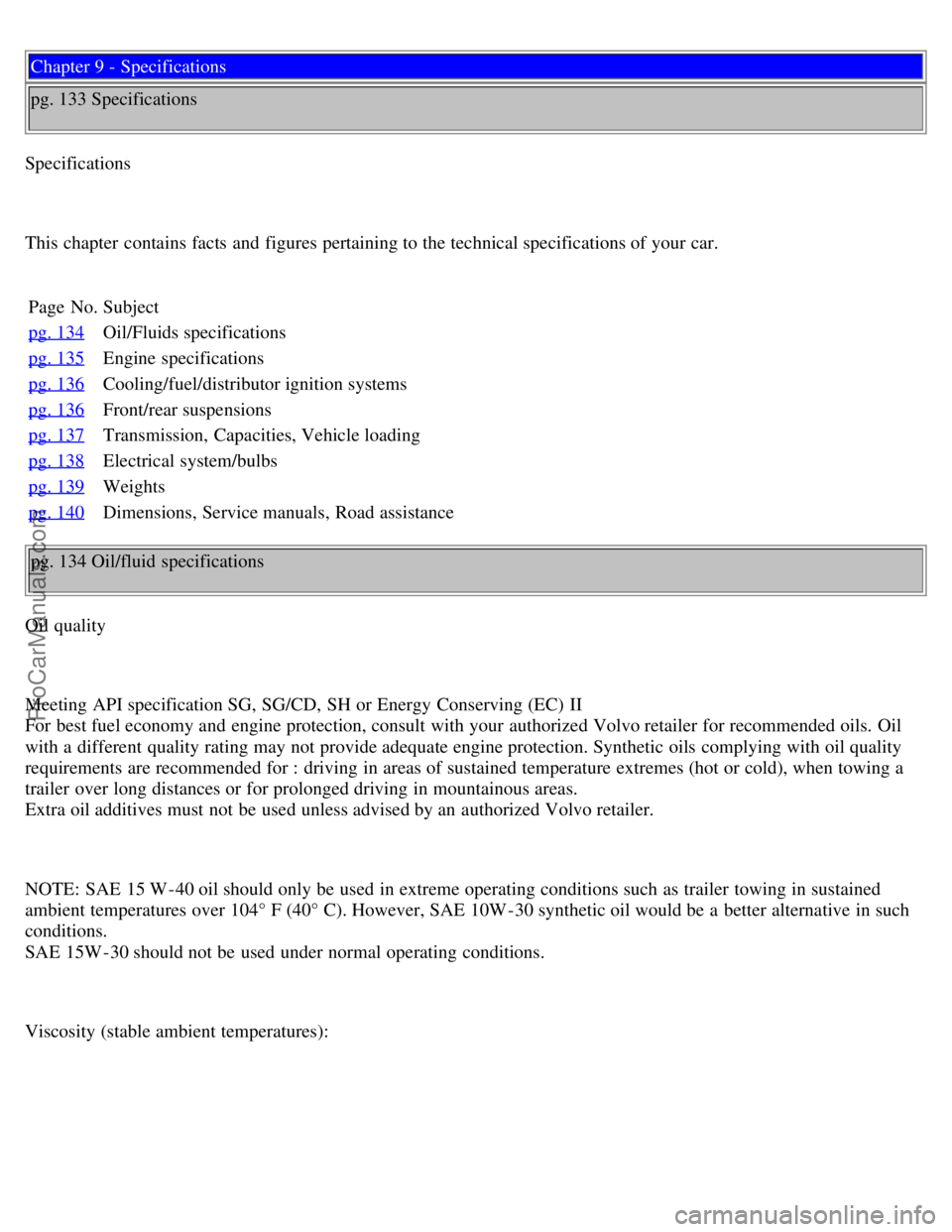
Chapter 9 - Specifications
pg. 133 Specifications
Specifications
This chapter contains facts and figures pertaining to the technical specifications of your car. Page No. Subject
pg. 134
Oil/Fluids specifications
pg. 135
Engine specifications
pg. 136
Cooling/fuel/distributor ignition systems
pg. 136
Front/rear suspensions
pg. 137
Transmission, Capacities, Vehicle loading
pg. 138
Electrical system/bulbs
pg. 139
Weights
pg. 140
Dimensions, Service manuals, Road assistance
pg. 134 Oil/fluid specifications
Oil quality
Meeting API specification SG, SG/CD, SH or Energy Conserving (EC) II
For best fuel economy and engine protection, consult with your authorized Volvo retailer for recommended oils. Oil
with a different quality rating may not provide adequate engine protection. Synthetic oils complying with oil quality
requirements are recommended for : driving in areas of sustained temperature extremes (hot or cold), when towing a
trailer over long distances or for prolonged driving in mountainous areas.
Extra oil additives must not be used unless advised by an authorized Volvo retailer.
NOTE: SAE 15 W -40 oil should only be used in extreme operating conditions such as trailer towing in sustained
ambient temperatures over 104° F (40° C). However, SAE 10W -30 synthetic oil would be a better alternative in such
conditions.
SAE 15W -30 should not be used under normal operating conditions.
Viscosity (stable ambient temperatures):
ProCarManuals.com
Page 44 of 61
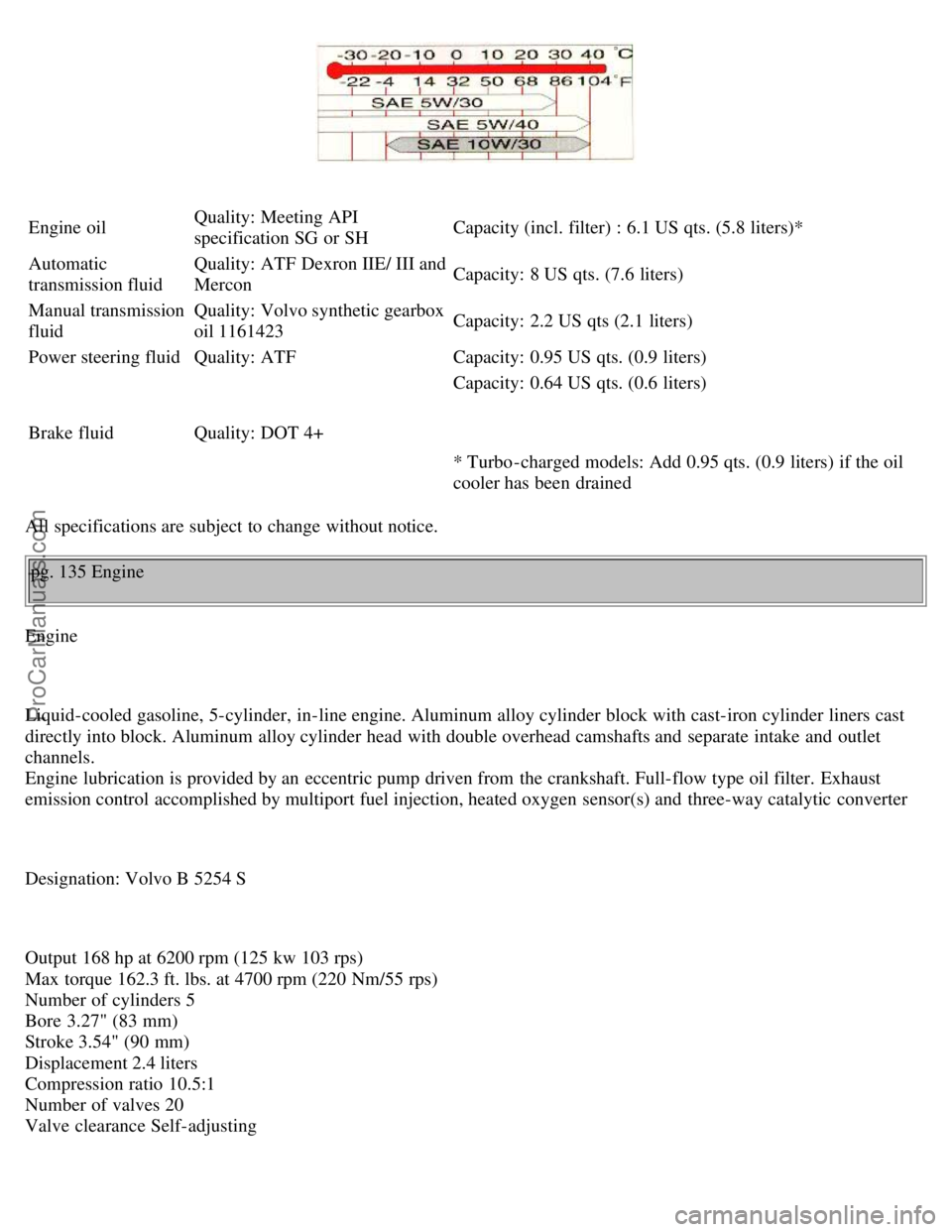
Engine oilQuality: Meeting API
specification SG or SH Capacity (incl. filter) : 6.1 US qts. (5.8 liters)*
Automatic
transmission fluid Quality: ATF Dexron IIE/ III and
Mercon
Capacity: 8 US qts. (7.6 liters)
Manual transmission
fluid Quality: Volvo synthetic gearbox
oil 1161423
Capacity: 2.2 US qts (2.1 liters)
Power steering fluid Quality: ATF Capacity: 0.95 US qts. (0.9 liters)
Brake fluid Quality: DOT 4+ Capacity: 0.64 US qts. (0.6 liters)
* Turbo -charged models: Add 0.95 qts. (0.9 liters) if the oil
cooler has been drained
All specifications are subject to change without notice.
pg. 135 Engine
Engine
Liquid-cooled gasoline, 5-cylinder, in-line engine. Aluminum alloy cylinder block with cast-iron cylinder liners cast
directly into block. Aluminum alloy cylinder head with double overhead camshafts and separate intake and outlet
channels.
Engine lubrication is provided by an eccentric pump driven from the crankshaft. Full-flow type oil filter. Exhaust
emission control accomplished by multiport fuel injection, heated oxygen sensor(s) and three-way catalytic converter
Designation: Volvo B 5254 S
Output 168 hp at 6200 rpm (125 kw 103 rps)
Max torque 162.3 ft. lbs. at 4700 rpm (220 Nm/55 rps)
Number of cylinders 5
Bore 3.27" (83 mm)
Stroke 3.54" (90 mm)
Displacement 2.4 liters
Compression ratio 10.5:1
Number of valves 20
Valve clearance Self-adjusting
ProCarManuals.com
Page 46 of 61
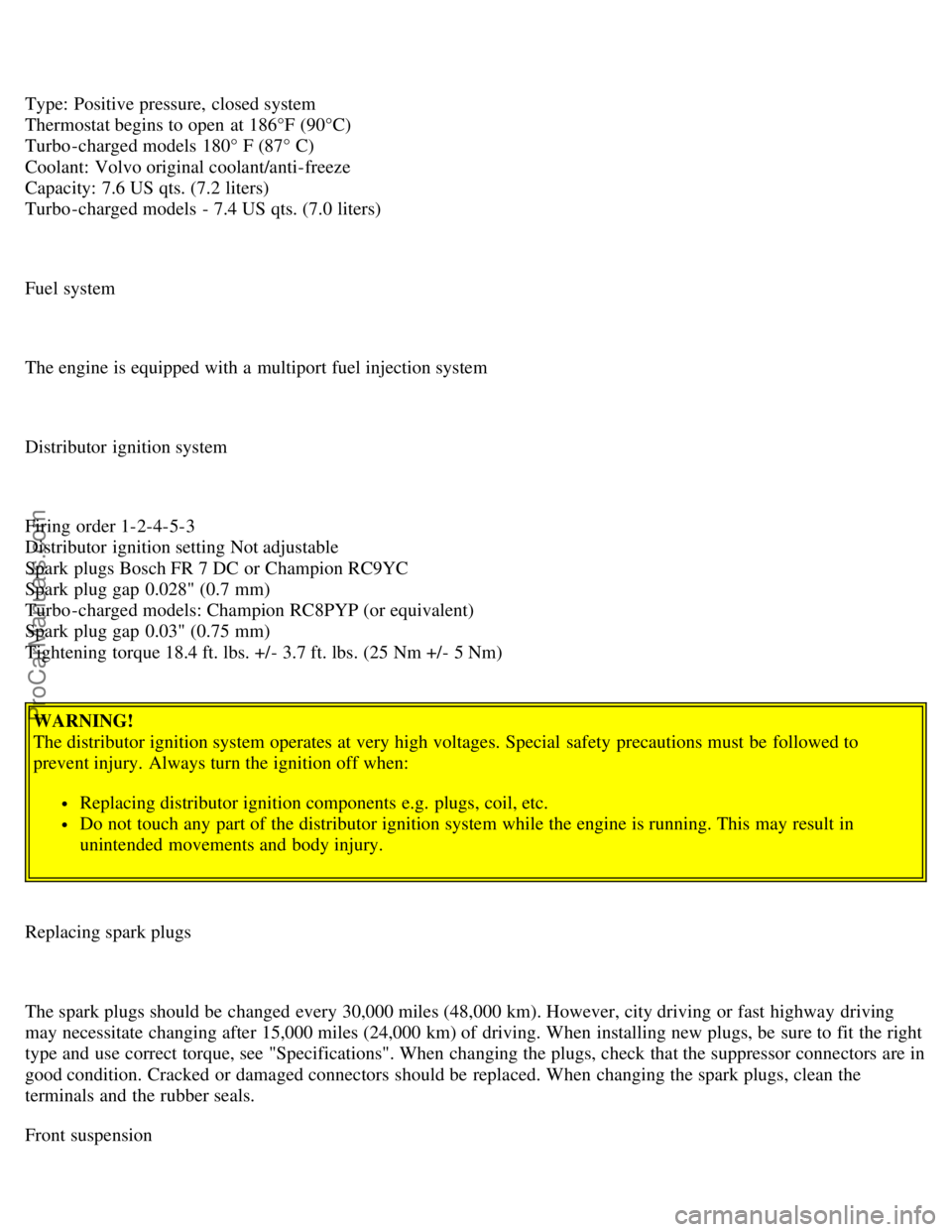
Type: Positive pressure, closed system
Thermostat begins to open at 186°F (90°C)
Turbo -charged models 180° F (87° C)
Coolant: Volvo original coolant/anti-freeze
Capacity: 7.6 US qts. (7.2 liters)
Turbo -charged models - 7.4 US qts. (7.0 liters)
Fuel system
The engine is equipped with a multiport fuel injection system
Distributor ignition system
Firing order 1-2-4-5-3
Distributor ignition setting Not adjustable
Spark plugs Bosch FR 7 DC or Champion RC9YC
Spark plug gap 0.028" (0.7 mm)
Turbo -charged models: Champion RC8PYP (or equivalent)
Spark plug gap 0.03" (0.75 mm)
Tightening torque 18.4 ft. lbs. +/- 3.7 ft. lbs. (25 Nm +/- 5 Nm)WARNING!
The distributor ignition system operates at very high voltages. Special safety precautions must be followed to
prevent injury. Always turn the ignition off when:
Replacing distributor ignition components e.g. plugs, coil, etc.
Do not touch any part of the distributor ignition system while the engine is running. This may result in
unintended movements and body injury.
Replacing spark plugs
The spark plugs should be changed every 30,000 miles (48,000 km). However, city driving or fast highway driving
may necessitate changing after 15,000 miles (24,000 km) of driving. When installing new plugs, be sure to fit the right
type and use correct torque, see "Specifications". When changing the plugs, check that the suppressor connectors are in
good condition. Cracked or damaged connectors should be replaced. When changing the spark plugs, clean the
terminals and the rubber seals.
Front suspension
ProCarManuals.com
Page 56 of 61
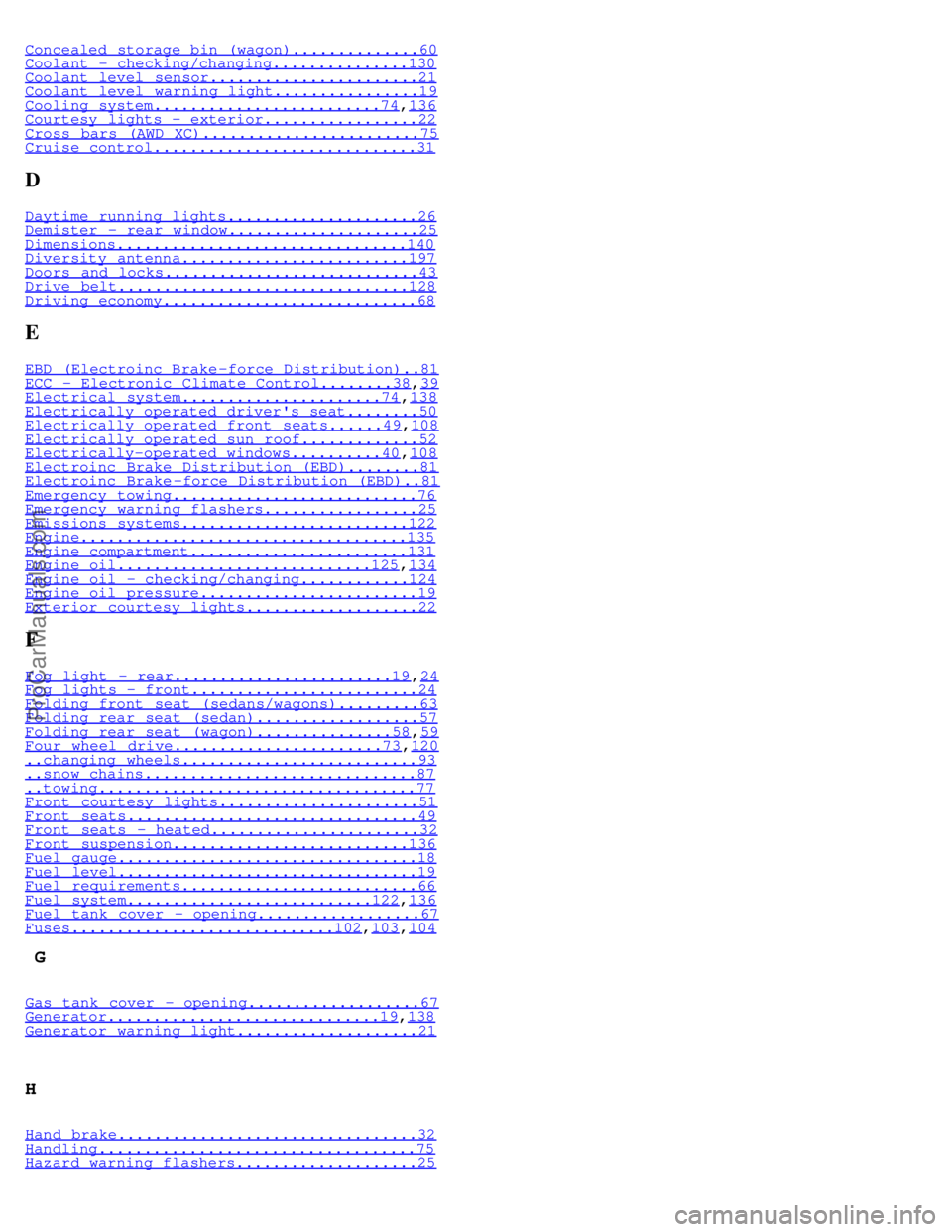
Concealed storage bin (wagon)..............60Coolant - checking/changing...............130Coolant level sensor.......................21Coolant level warning light................19Cooling system.........................74,136Courtesy lights - exterior.................22Cross bars (AWD XC)........................75Cruise control.............................31
D
Daytime running lights.....................26Demister - rear window.....................25Dimensions................................140Diversity antenna.........................197Doors and locks............................43Drive belt................................128Driving economy............................68
E
EBD (Electroinc Brake -force Distribution)..81ECC - Electronic Climate Control........38,39Electrical system......................74,138Electrically operated driver's seat........50Electrically operated front seats......49,108Electrically operated sun roof.............52Electrically-operated windows..........40,108Electroinc Brake Distribution (EBD)........81Electroinc Brake -force Distribution (EBD)..81Emergency towing...........................76Emergency warning flashers.................25Emissions systems.........................122Engine....................................135Engine compartment........................131Engine oil............................125,134Engine oil - checking/changing............124Engine oil pressure........................19Exterior courtesy lights...................22
F
Fog light - rear........................19,24Fog lights - front.........................24Folding front seat (sedans/wagons).........63Folding rear seat (sedan)..................57Folding rear seat (wagon)...............58,59Four wheel drive.......................73,120..changing wheels..........................93..snow chains..............................87..towing...................................77Front courtesy lights......................51Front seats................................49Front seats - heated.......................32Front suspension..........................136Fuel gauge.................................18Fuel level.................................19Fuel requirements..........................66Fuel system...........................122,136Fuel tank cover - opening..................67Fuses.............................102,103,104
G
Gas tank cover - opening...................67Generator..............................19,138Generator warning light....................21
H
Hand brake.................................32Handling...................................75Hazard warning flashers....................25
ProCarManuals.com
Page 58 of 61
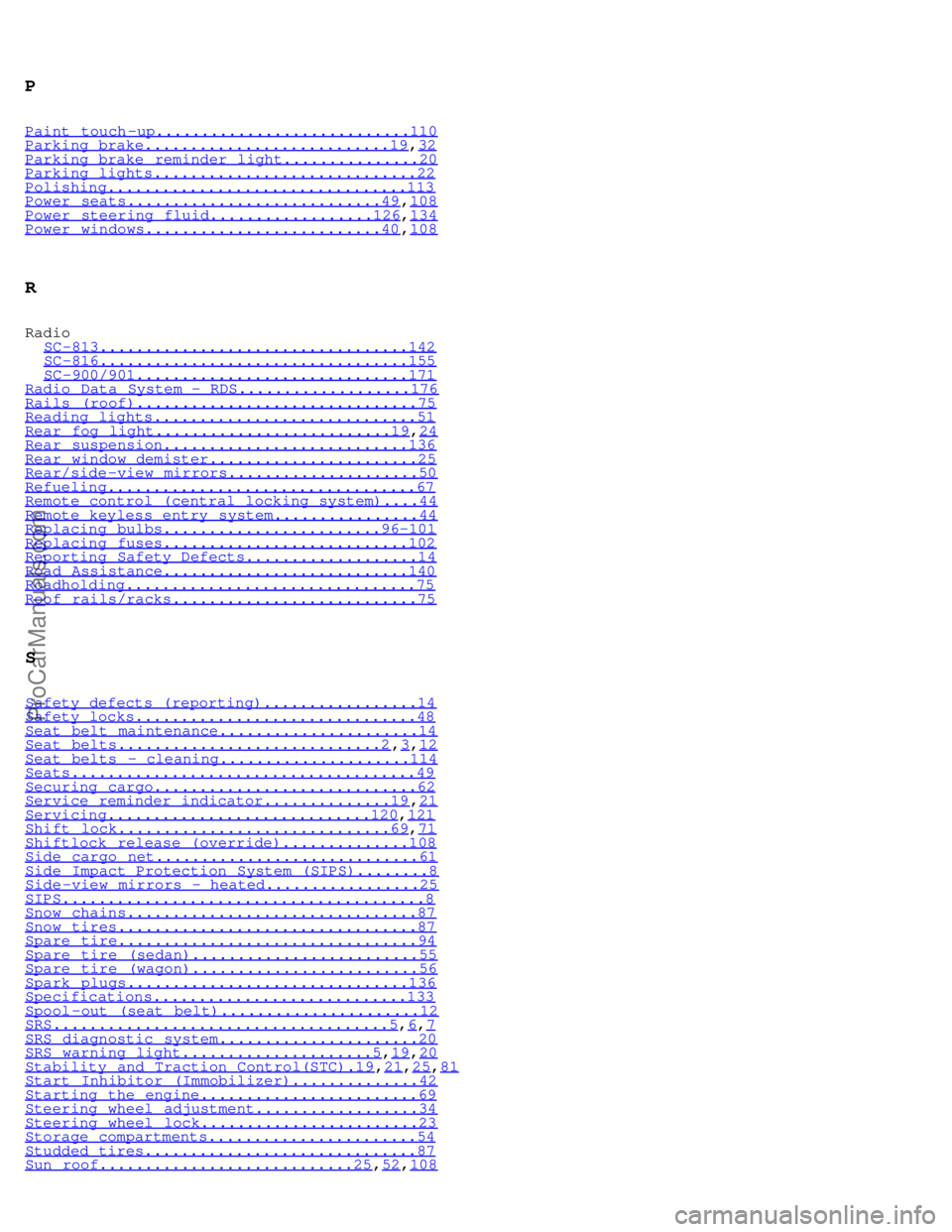
P
Paint touch -up............................110Parking brake...........................19,32Parking brake reminder light...............20Parking lights.............................22Polishing.................................113Power seats............................49,108Power steering fluid..................126,134Power windows..........................40,108
R
Radio
SC-813..................................142
SC-816..................................155 SC-900/901..............................171Radio Data System - RDS...................176Rails (roof)...............................75Reading lights.............................51Rear fog light..........................19,24Rear suspension...........................136Rear window demister.......................25Rear/side -view mirrors.....................50Refueling..................................67Remote control (central locking system)....44Remote keyless entry system................44Replacing bulbs........................96-101Replacing fuses...........................102Reporting Safety Defects...................14Road Assistance...........................140Roadholding................................75Roof rails/racks...........................75
S
Safety defects (reporting).................14Safety locks...............................48Seat belt maintenance......................14Seat belts.............................2,3,12Seat belts - cleaning.....................114Seats......................................49Securing cargo.............................62Service reminder indicator..............19,21Servicing.............................120,121Shift lock..............................69,71Shiftlock release (override)..............108Side cargo net.............................61Side Impact Protection System (SIPS)........8Side -view mirrors - heated.................25SIPS........................................8Snow chains................................87Snow tires.................................87Spare tire.................................94Spare tire (sedan).........................55Spare tire (wagon).........................56Spark plugs...............................136Specifications............................133Spool -out (seat belt)......................12SRS.....................................5,6,7SRS diagnostic system......................20SRS warning light.....................5,19,20Stability and Traction Control(STC).19,21,25,81Start Inhibitor (Immobilizer)..............42Starting the engine........................69Steering wheel adjustment..................34Steering wheel lock........................23Storage compartments.......................54Studded tires..............................87Sun roof............................25,52,108
ProCarManuals.com
Page 60 of 61
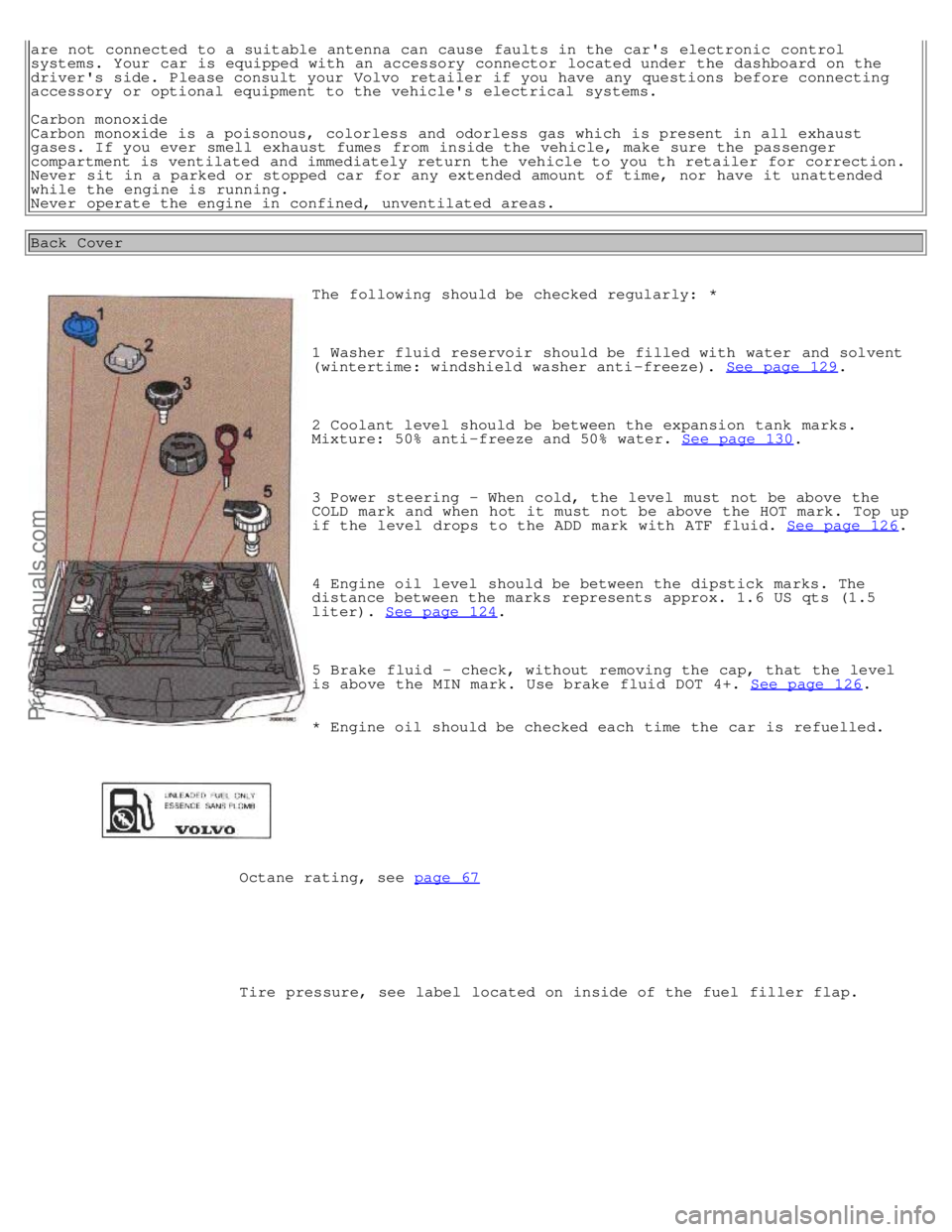
are not connected to a suitable antenna can cause faults in the car's electronic controlsystems. Your car is equipped with an accessory connector located under the dashboard on the
driver's side. Please consult your Volvo retailer if you have any questions before connecting
accessory or optional equipment to the vehicle's electrical systems.
Carbon monoxide
Carbon monoxide is a poisonous, colorless and odorless gas which is present in all exhaust
gases. If you ever smell exhaust fumes from inside the vehicle, make sure the passenger
compartment is ventilated and immediately return the vehicle to you th retailer for correction.
Never sit in a parked or stopped car for any extended amount of time, nor have it unattended
while the engine is running.
Never operate the engine in confined, unventilated areas.
Back Cover
The following should be checked regularly: *
1 Washer fluid reservoir should be filled with water and solvent
(wintertime: windshield washer anti -freeze). See page 129
.
2 Coolant level should be between the expansion tank marks.
Mixture: 50% anti -freeze and 50% water. See page 130
.
3 Power steering - When cold, the level must not be above the
COLD mark and when hot it must not be above the HOT mark. Top up
if the level drops to the ADD mark with ATF fluid. See page 126
.
4 Engine oil level should be between the dipstick marks. The
distance between the marks represents approx. 1.6 US qts (1.5
liter). See page 124
.
5 Brake fluid - check, without removing the cap, that the level
is above the MIN mark. Use brake fluid DOT 4+. See page 126
.
* Engine oil should be checked each time the car is refuelled.
Octane rating, see page 67
Tire pressure, see label located on inside of the fuel filler flap.
ProCarManuals.com